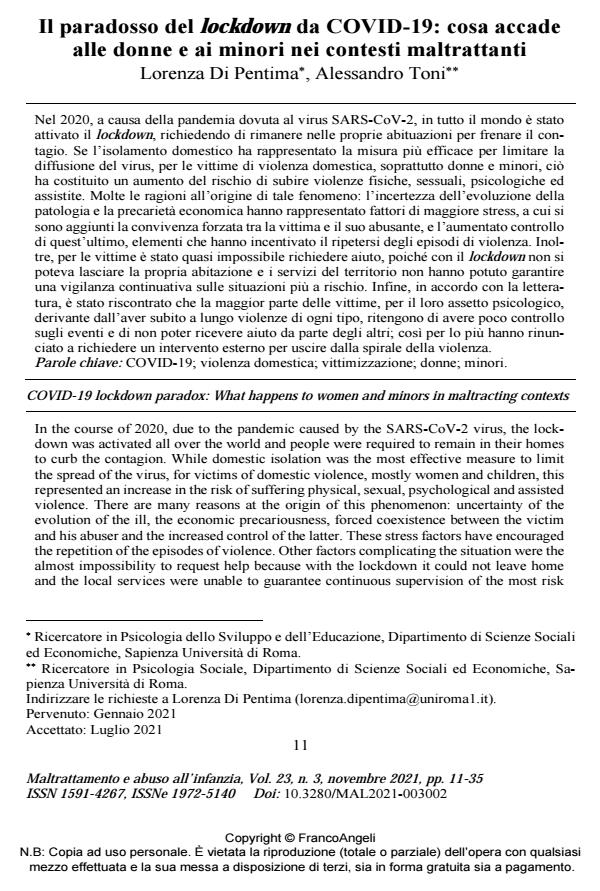Il paradosso del lockdown da COVID-19: cosa accade alle donne e ai minori nei contesti maltrattanti
Titolo Rivista MALTRATTAMENTO E ABUSO ALL’INFANZIA
Autori/Curatori Lorenza Di Pentima, Alessandro Toni
Anno di pubblicazione 2021 Fascicolo 2021/3
Lingua Italiano Numero pagine 25 P. 11-35 Dimensione file 266 KB
DOI 10.3280/MAL2021-003002
Il DOI è il codice a barre della proprietà intellettuale: per saperne di più
clicca qui
Qui sotto puoi vedere in anteprima la prima pagina di questo articolo.
Se questo articolo ti interessa, lo puoi acquistare (e scaricare in formato pdf) seguendo le facili indicazioni per acquistare il download credit. Acquista Download Credits per scaricare questo Articolo in formato PDF

FrancoAngeli è membro della Publishers International Linking Association, Inc (PILA)associazione indipendente e non profit per facilitare (attraverso i servizi tecnologici implementati da CrossRef.org) l’accesso degli studiosi ai contenuti digitali nelle pubblicazioni professionali e scientifiche
Nel 2020, a causa della pandemia dovuta al virus SARS-CoV-2, in tutto il mondo è stato attivato il lockdown, richiedendo di rimanere nelle proprie abituazioni per frenare il contagio. Se l’isolamento domestico ha rappresentato la misura più efficace per limitare la diffusione del virus, per le vittime di violenza domestica, soprattutto donne e minori, ciò ha costituito un aumento del rischio di subire violenze fisiche, sessuali, psicologiche ed assistite. Molte le ragioni all’origine di tale fenomeno: l’incertezza dell’evoluzione della patologia e la precarietà economica hanno rappresentato fattori di maggiore stress, a cui si sono aggiunti la convivenza forzata tra la vittima e il suo abusante, e l’aumentato controllo di quest’ultimo, elementi che hanno incentivato il ripetersi degli episodi di violenza. Inoltre, per le vittime è stato quasi impossibile richiedere aiuto, poiché con il lockdown non si poteva lasciare la propria abitazione e i servizi del territorio non hanno potuto garantire una vigilanza continuativa sulle situazioni più a rischio. Infine, in accordo con la letteratura, è stato riscontrato che la maggior parte delle vittime, per il loro assetto psicologico, derivante dall’aver subito a lungo violenze di ogni tipo, ritengono di avere poco controllo sugli eventi e di non poter ricevere aiuto da parte degli altri; così per lo più hanno rinunciato a richiedere un intervento esterno per uscire dalla spirale della violenza.
Parole chiave:COVID-19; violenza domestica; vittimizzazione; donne; minori.
Lorenza Di Pentima, Alessandro Toni, Il paradosso del lockdown da COVID-19: cosa accade alle donne e ai minori nei contesti maltrattanti in "MALTRATTAMENTO E ABUSO ALL’INFANZIA" 3/2021, pp 11-35, DOI: 10.3280/MAL2021-003002